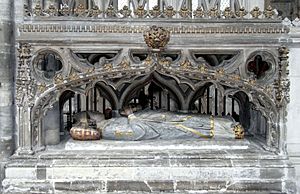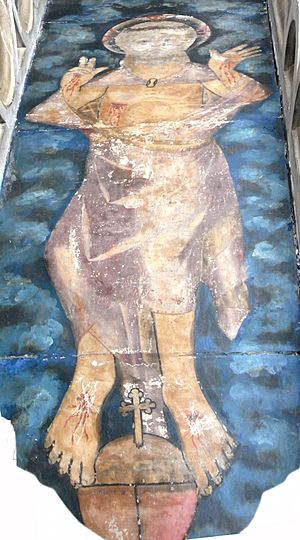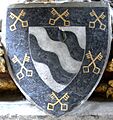Walter de Stapledon facts for kids
Quick facts for kids Walter de Stapledon |
|
|---|---|
| Bishop of Exeter | |
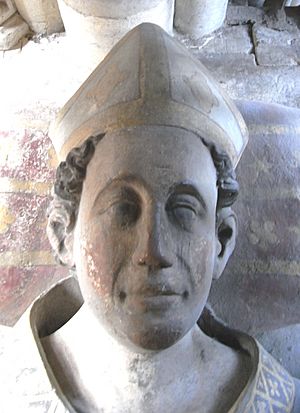
Walter de Stapledon (1261–1326), Bishop of Exeter. Detail from his effigy in Exeter Cathedral
|
|
| Appointed | 13 March 1307 |
| Reign ended | 14 October 1326 |
| Predecessor | Thomas Bitton |
| Successor | James Berkeley |
| Personal details | |
| Born | 1 February 1261 Cookbury or Annery, Devonshire |
| Died | 14 October 1326 London |
| Denomination | Catholic |
| Previous post | Papal chaplain |
Walter de Stapledon (born February 1, 1261 – died October 14, 1326) was an important person in English history. He served as the Bishop of Exeter from 1308 to 1326. He was also chosen twice to be the Lord High Treasurer of England, which meant he managed the country's money. Walter de Stapledon started Exeter College, Oxford, a famous university college. He also helped a lot with rebuilding Exeter Cathedral. His special tomb and monument are still there today in Exeter Cathedral. Sadly, he was killed by a large group of people during a time of trouble in London.
Contents
Who Was Walter de Stapledon?
Walter Stapledon was born in Devon, England. His family was well-known. He was the son of Sir Richard Stapledon. The family came from a place called Stapledon in Cookbury.
His older brother was Richard Stapledon, who was a judge. Richard also has a monument in Exeter Cathedral, close to his brother the bishop's.
His Early Career
Walter Stapledon became a professor at Oxford University. He taught canon law, which are the rules and laws of the Christian Church. He also worked as a chaplain for Pope Clement V.
On March 13, 1307, he was chosen to be the Bishop of Exeter. He officially became bishop on October 13, 1308. Soon after, he held a very large ordination ceremony. This was when people become priests or deacons. Over 1,000 people were ordained in Crediton, which was a record for the Exeter area.
Working for the King
Walter de Stapledon traveled to France for both King Edward I and King Edward II. He also attended important meetings and parliaments of his time.
He was appointed Lord High Treasurer of England twice. This important job meant he was in charge of the country's money. He held this role in 1320 and again in 1322.
Founding Exeter College, Oxford
Bishop Stapledon founded Exeter College, Oxford. It started as Stapeldon Hall in 1314. He created it with his older brother, Sir Richard Stapeldon.
For many centuries, sons of important families from Devon went to this college. The college still uses Bishop Stapledon's family crest as its symbol.
His Death and Burial
Bishop Stapledon was seen by many as being too close to King Edward II. The king was having problems with his wife, Queen Isabella. When the king left London, he made Bishop Stapledon the "Keeper" of the city. However, most people in London supported Queen Isabella.
Bishop Stapledon tried to get the keys to the city gates to keep the Queen out. But the people of London were angry. They planned to capture and harm the bishops who supported the king.
Bishop Stapledon was attacked while riding through the city. His older brother, Richard de Stapledon, tried to save him. Richard was pulled from his horse and killed by the angry crowd. This happened near Cripplegate.
Bishop Stapledon tried to find safety in St Paul's Cathedral. But the mob followed him inside. They dragged him out and attacked him. He was killed at Cheapside on October 15, 1326. His body was left in a disrespectful way.
Later, some of his supporters secretly buried his body near the River Thames. About six months later, Queen Isabella ordered his body to be moved. She wanted him to have a proper burial. His body was moved to Exeter Cathedral on March 28, 1327. He was given a grand funeral there.
His Monument
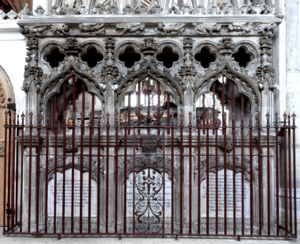
Bishop Stapledon's monument is in Exeter Cathedral. It is on the north side of the main altar. It is one of the most important monuments from the 1300s in the cathedral.
The monument shows a statue of the bishop lying down. It is made of a type of stone called Beer stone. The statue shows him wearing his bishop's robes. He holds a crozier, which is a bishop's staff, in his left hand. He holds a book in his right hand.
At his feet, you can see a shield with his family's coat of arms. On the ceiling of the monument, there is a hidden painting. It shows Christ with his Five Holy Wounds.
Over the years, the monument has been repaired and repainted several times. In the 1980s, the old painting on the ceiling was carefully restored.
Images for kids
-
Arms of Bishop Walter de Stapledon (1261–1326), Bishop of Exeter, Detail from his monument in Exeter Cathedral (restored): Argent, two bends undée sable (Stapledon) within a bordure of the last charged with six pairs of keys addorsed and interlaced the wards upwards or (bordure of Bishop Stapledon, being the arms of the See of Exeter)


